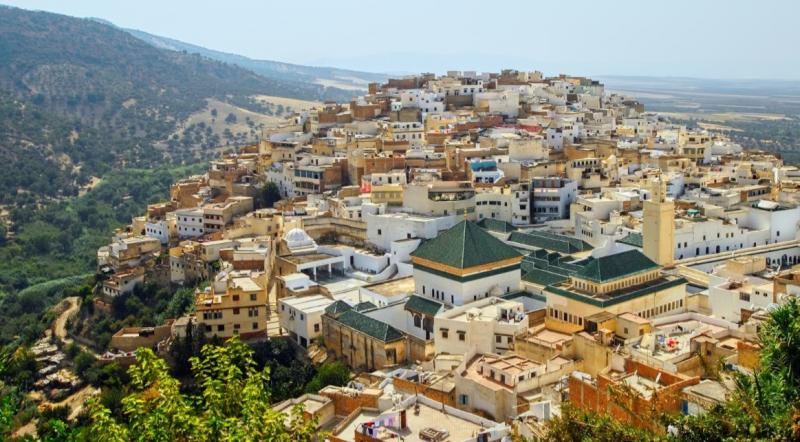
Explore the hidden depths of Morocco
Casablanca’s reconstructed Rick’s Café, the crowded streets of Marrakech enveloped in tourist paraphernalia and snake charmers, the enormous Game of Thrones sets in Ouarzazate—like in any country, it is all too easy to reduce the richness of Morocco into a few hastily researched Western items to be simply checked off a long list of attractions. However, Morocco, a fusion of Arab heritage, North African influences, and French inspiration forges a unique blend of typical western attractions and more authentically Moroccan sights. Yet, the sometimes overwhelming abundance of choice leaves your head whirling with indecision. Where are the best Kasbahs, the most beautiful mosques, the oldest medinas? Where does one begin or even hope to achieve an authentic tour of Morocco? Sian Hanson embarked upon a journey to unearth the answer to these questions and discover first-hand why it is better to veer away from the tourist itinerary in favour of some new and unexpected treasures.
Rabat: The City of Ruins
An often overlooked city, Morocco’s capital boasts some of the finest historical architecture and ruins in the country, the vestiges of Phoneticians, Berber tribes, Romans, and early Arab settlers strewn about the city. Hidden in the green outskirts of Rabat, the daunting medieval fortress walls of Chellah encircle the ancient Roman ruins of Sala Colonia. Though plush green grass and colourful wild flowers now attempt to reclaim the crumbling faceless statues and toppled columns, the lingering stone remnants form the foundation of what was once a typical Roman city, complete with the signature archway facing Rome and tall temples dedicated to one of the many gods. Abandoned by the 12th century, Sala Colonia began to disintegrate, eventually nothing more than a cemetery with royal tombs that are now cracked and worn.
After 200 years of ruin, Abou al-Hassan Ali, a sultan of the Marinid dynasty, ordered the construction of a large necropolis installed in place of the Roman ruins with a defensive fort for protection against the invading Spaniards. The intimidating stone walls and ramparts still stand untouched today though the necropolis has long since fallen, the orange stone fragments jumbled in with the pale white Roman ruins. Over the next few centuries, the inner courtyard became home to a small mosque and medersa, an Islamic theological school.
While the roofs of both mosque and medersa caved in long ago, the arched doorways and segments of painted walls. The impressive minaret stands almost untouched with geometric turquoise mosaics glinting in the sunshine beneath the large stork nests, the birds lazily flying overhead and patiently perching on the ruins to watch their visitors. Hidden beneath a huddle of large trees is the eel pool, where women would once crack eggs over the murky surfaces for increased fertility and where, today, dozens of cats lazily snooze in the afternoon sun.
Fes: The Labyrinth
Essentially a large bowl slowly spiralling into the depths of the tanneries, Fes’ medina is the largest in the world. A crowded assortment of tan buildings and green roofs haphazardly stacked on top of one another, the medina sprawls across foothills with the Atlas Mountains a distant mirage on the horizon.
Constructed in the early ninth century, Fes has remained the spiritual, cultural, and academic capital of Morocco for over a thousand years. The world’s oldest university, founded by Fatima al-Fihri in 859 AD, sits in the heart of the medina, the white-tiled floors, bubbling fountains, and green-tiled roofs a testimony to Islamic architecture and engineering.
The world-renowned tanneries stand nearby, leather shops selling an assortment of purses, boots, and jackets overlooking the hundreds of bowls of dye and workshops. Congested alleys branch out from the medina’s centre, lined with freshly painted pottery, hanging leather purses, bejewelled slippers, sterling silver Berber earrings, and ornate mosque doors. The mouthwatering scent of freshly baked bread, spicy tagine, and mint tea waft into the bustling streets filled with endless rows of stalls selling fresh olives and warm pastries. And, if you pass by at just the right moment, you may be able to steal a glance into one of the lavish riads hiding behind deceptively plain wooden doors.
Donkeys, led by their owners, slowly meander the streets, replacing the forbidden cars and serving as the backbone to the medina’s delicate economy. Continue outwards to climb up to Café Clock’s rooftop gardens, which reveal a stunning panoramic view of Fes, the vibrant green and yellow mosaics of the nearby minaret only a few metres away. Finally, the bright blue Bab Boujloud gates offer one of the few outlets from the chaotic medieval medina, a busy flow of Moroccans entering and exiting at all hours.
Moulay-Idriss: The Forgotten City on a Hill
Moulay-Idriss appears to have grown in the shape of a jagged white hill comprised of mosques, mausoleums, and small homes with protruding green-tiled roofs attempting to blend into the neighbouring tree-covered hills. Steep winding staircases slowly crawl up the hill, Mount Zerhoun, small baby blue doors and lone cats lining hundreds of steps with the slightest scent of olive oil, a local commodity, hanging in the air.
Climb to the summit and the magnificent Roman ruins of Volubilis less than 5km (3mi) away remain indistinguishable from the surrounding vast plains of Meknes. A rare circular minaret made from forest green tiles hides behind pale yellow buildings, a verse from the Qur’an written out in both Arabic and Berber. Named for Moulay Idriss el Akhbar, a great-grandson of Muhammad, who is credited with bringing Islam to Morocco and the first king of Morocco, the city is considered the fifth most important Muslim site in the world. Five pilgrimages to the tomb of Moulay Idriss equate a completed Hajj, leading to the popular nickname a ‘Poor Man’s Mecca.’ Morocco’s holiest site, non-Muslims were forbidden from staying in the city limits overnight until 2005. As a result, Moulay-Idriss remains relatively untouched by 21st century tourism and retains much of its medieval charm.
Often overlooked in favour of Morocco’s larger metropolitan cities, Moulay-Idriss boasts a slow pace and laid-back attitude that contrasts the usual hustle and bustle of the crowded medinas and offers a refreshing break from the modern villes nouvelles. In her book In Morocco, American author Edith Wharton described how “the silence and emptiness of the place began to strike us,” broken only by the yearly mousseum that produced a “spectacle unrolling itself below us” that “took on a blessed air of unreality.”
Essaouira: The Seaside Escape
Perched on the shores of the Atlantic away from the heat and crowded streets of Marrakech, Essaouira is an unassuming and relaxing coastal destination. The fortress walls of the Skala Kasbah trace the shoreline and protect the white-walled medina inside from the crashing waves of the ocean. Palm trees lazily slouch along the coast line and the enchanting Mogador archipelago is only a short boat ride from the shore.
Famed for Jimi Hendrix’s visit in 1969 and iconic scenes from Game of Thrones, Essaouira is nonetheless known as the “Wind City of Africa” for the gale force winds that wreak havoc on the coast. A mixture of jagged rocks and sandy beaches—with the occasional camel strolling into the shallow waters—melt into the turquoise waters of the ocean, hundreds of crying seagulls flying overhead and hovering above the blue fishing boats with worn wooden oars docked haphazardly in the Essaouira port.
Orange peels decoratively hang from stalls of fruit merchants along the ramparts leading to the port (where the famous fish auction unfolds) while local artists sell small water colours and large oil paintings. The stone walls of the surrounding fortress, or kasbah, bears a striking resemblance to the Breton town of St. Malo in northwest France, the architecture of this kasbah greatly influenced and inspired by French engineer Vauban, who designed St. Malo’s fortress. Rusted canons and look-out alcoves survey the sea and a woodworking souq sits hidden beneath the protective walls. Yet, wander into the medina centre and the peeling white walls and bright blue shutters and doors will transport you to a Greek coastal town. This picturesque multicultural seaside town promises a respite from the typical bustling Moroccan metropolis with all the benefits of a coastal city.
Berber Villages: A Trek from the Atlas Mountains to the Sahara
Of course, no trip to Morocco is complete without venturing into the Sahara Desert and embarking on an unforgettable camel ride into the sand dunes from one of the local Berber villages. While arguably a clichéd tourist attraction, the natural wonders of the Sahara are not to be missed on a trip to Morocco.
As the indigenous nomadic population of Morocco, Berber tribes have long inhabited looming snow-capped Atlas Mountains the desert and oases of the Sahara Desert, their culture and language distinct from those of the Arab settlers. While some traditions have been lost and Berber tribes have historically been forced further and further south due to Arab settlements, Spanish invasions, and French colonisation, recent education reforms now require Berber to be taught in schools and there exists a renewed effort to preserve and protect Berber customs.
The beautiful Berber villages, many of which are hidden in the cliffs of the High Atlas Mountains, appear to sprout from the ground, the brown stones of the homes and buildings perfectly blending into their mountainous landscape. Other villages, located in the outskirts or directly in the Sahara, are comprised of a group of tents covered in colourful scarves and precariously propped up by short wooden beams. Rent a small, cosy tent for the night and huddle beneath the luminous starry sky and wake up in the early hours of the morning for a journey into the depths of the Sahara on camelback. Camels will lazily saunter into the seemingly endless sea of orange sand dunes with you perched on their hump, surveying the breath-taking scenery. Hike up to the summits of the massive sand dunes to witness the magnificent sunrise, the suns orange orb illuminating the landscape.
Share this article:



















